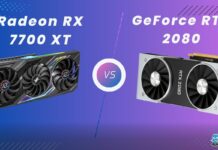As an avid AMD enthusiast, I found myself faced with the perpetual evolution of graphics cards, keeping buyers like me perpetually intrigued. In my pursuit of the best AMD has to offer, the choice between the Radeon RX 7900 XTX vs Radeon RX 6900 XT left me uncertain. This in-depth comparison dives into the distinctions between these two top-tier AMD graphics cards, aiding you in making an informed decision.
Key Takeaways
- My findings reveal that the Radeon RX 7900 XTX excels in 4K gaming, showcasing a remarkable 44.8% improvement in average FPS performance compared to the Radeon RX 6900 XT.
- The power-hungry nature of the Radeon RX 7900 XTX becomes evident, drawing an average of 19.4% more power than the Radeon RX 6900 XT in my 4K gaming benchmarks.
- The Radeon RX 7900 XTX averaged a temperature of 66.9°C, with the Radeon RX 6900 XT slightly warmer at 70.1°C, highlighting AMD’s new GPUs’ impressive efficiency despite the minor 4.6% difference.
Comparison Table
| Technical Specs | Radeon RX 7900 XTX | Radeon RX 6900 XT |
| GPU Name | Navi 31 | Navi 21 |
| Architecture | RDNA 3.0 | RDNA 2.0 |
| Transistors | 57,700 million | 26,800 million |
| Shading Units | 6144 | 5120 |
| Tensor Cores | NA | NA |
| RT Cores | 96 | 128 |
| TMUs | 384 | 320 |
| ROPs | 192 | 128 |
| L1 Cache | 256 KB per Array | 128 KB per Array |
| L2 Cache | 6 MB | 4 MB |
| Memory Bus Width | 384 bit | 256 bit |
| Memory Bandwidth | 960.0 GB/s | 512.0 GB/s |
| Suggested PSU | 750W | 700W |
| Release Date | Nov 3rd, 2022 | Oct 28th, 2020 |
| Approximated Price | 999 USD | 800 USD |
| Best Variants | BEST RX 7900 XTX Cards | Best RX 6900 XT Cards |
Architectural Differences
- Process Node: The RX 7900 XTX boasts a 5nm process node, while the RX 6900 XT utilizes a 7nm process node, potentially influencing power efficiency and performance.
- Clock Speed: With a higher 1855 MHz Base Clock and 2499 MHz Boost Clock, the RX 7900 XTX exhibits enhanced clock speeds compared to the RX 6900 XT, which features an 1825 MHz Base Clock and 2250 MHz Boost Clock.
- VRAM: The RX 7900 XTX offers a substantial 24GB of GDDR6 VRAM, outclassing the RX 6900 XT’s 16GB GDDR6, which could impact high-resolution gaming and content creation.
- TDP: The RX 7900 XTX features a higher TDP of 355W, while the RX 6900 XT maintains a 300W TDP, potentially influencing power consumption and heat dissipation.
- Supported Technologies: Both the RX 7900 XTX and RX 6900 XT are equipped with FSR 3.0 (FidelityFX Super Resolution) support, enhancing gaming performance and upscaling capabilities.
Also Read: RX 7900 XTX Vs Radeon RX 6950 XT
Radeon RX 7900 XTX Vs Radeon RX 6900 XT 4K Gaming Benchmarks
It is understandable for a graphics card that was released later to be better in terms of specifications. However, the true seal of performance can only be earned when it performs well in gaming. That’s what I am about to do. I’ll test the performance of the two cards at 4K resolution in 10 games.
Testing Rig
- CPU: Core i9 13900K
- Operating System: Windows 11
- Motherboard: ASUS TUF Gaming Z690-Plus
- RAM: G.Skill Trident Z5 RGB 32GB DDR5-6600 CL34
- SSD: Sabrent Rocket 4 Plus 1TB NVMe SSD
- Cooler: Xigmatek Aurora 360mm Cooler
- Power Supply: ENERMAX REVOLUTION D.F. X 1050W
Apex Legends
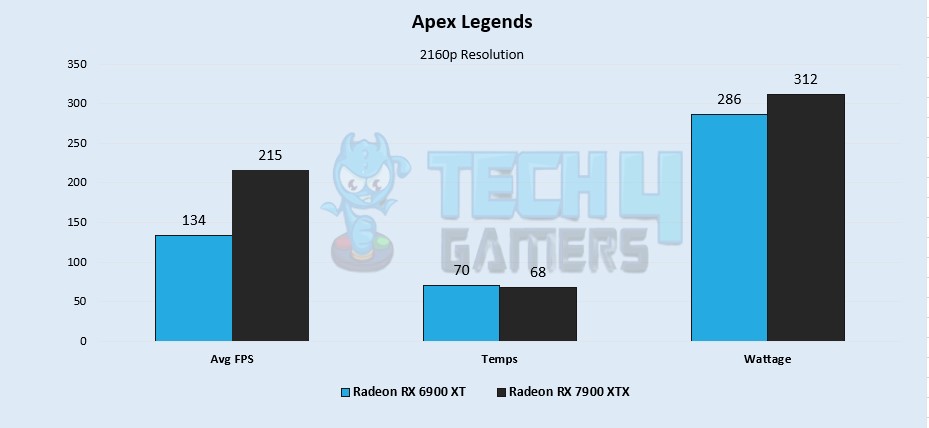
- Starting with Apex Legends, the Radeon RX 7900 XTX delivered impressive FPS performance by keeping an average of 215 FPS compared to an average of 134 FPS by the Radeon RX 6900 XT.
- By consistently producing more frames per second, the Radeon RX 7900 XTX was 60% better than the Radeon RX 6900 XT.
- Both cards consume much power, but I noticed that the Radeon RX 7900 XTX consumes a lot of extra watts at 312W compared to 286W on the Radeon RX 6900 XT.
- I conducted extensive testing to compare the temperatures. The results showed that the Radeon RX 7900 XTX ran at 68°C, which was 2°C cooler than the Radeon RX 6900 XT.
Also Read: RTX 4070 Vs RX 7900 XTX
Call Of Duty Warzone 2
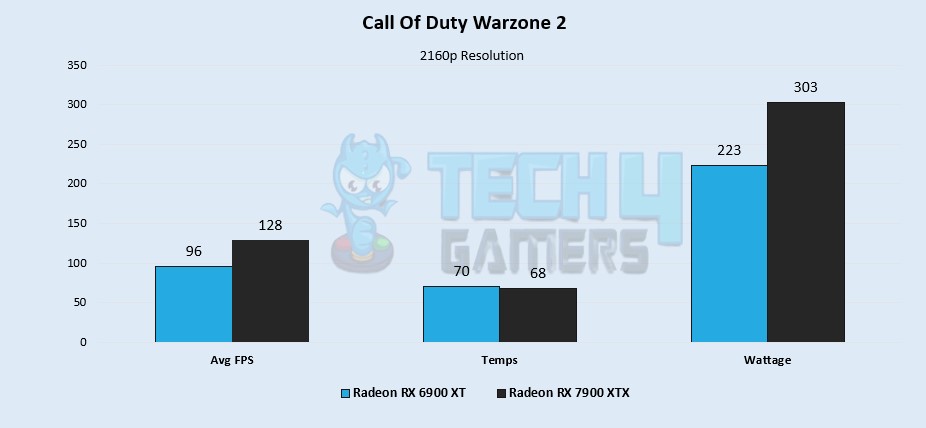
- In my benchmark, the Radeon RX 7900 XTX produced an average of 128 FPS vs 96 FPS from the Radeon RX 6900 XT, and I also saw the Low 1% and Low 0.1% were also better on the Radeon RX 7900 XTX.
- Based on my thorough testing, the Radeon RX 7900 XTX exhibited a commendable performance improvement with an average frame rate that was more than 33% higher than its predecessor.
- Moreover, my testing revealed there was a huge gap in power consumption with the Radeon RX 6900 XT using only 223W, which makes it almost 36% more efficient than the RX 7900 XTX.
- Despite using much more power than the Radeon RX 6900 XT, I found that the Radeon RX 7900 XTX remains at 68°C, which is quite impressive.
Cyberpunk 2077
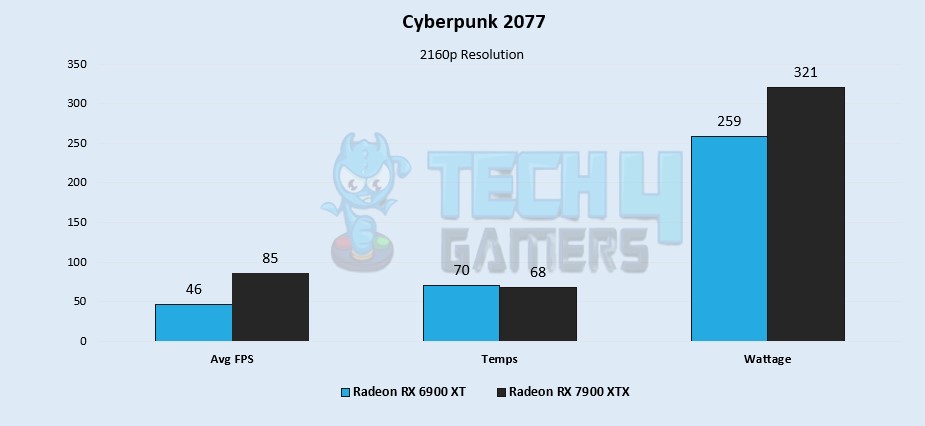
- Cyberpunk 2077 is a graphics-heavy game, and it became clear from my benchmark testing that even the Radeon RX 7900 XTX could give us only an 85 FPS average.
- Things went down further for the Radeon RX 6900 XT as it was able to deliver only 46 FPS average, which is only 54% of what we’re getting from Radeon RX 7900 XTX.
- As I conducted my tests, it was evident that the power consumption difference between the two cards existed. The Radeon RX 7900 XTX consumed 321W, which was notably 62W more than the power utilized by the Radeon RX 6900 XT.
- Yet again, I see the Radeon RX 7900 XTX proves to be the cooler one, with only 68°C on the temperature reader compared to 70°C on the Radeon RX 6900 XT.
Similar Comparison: RTX 3090 Ti Vs RX 7900 XTX
F1 22
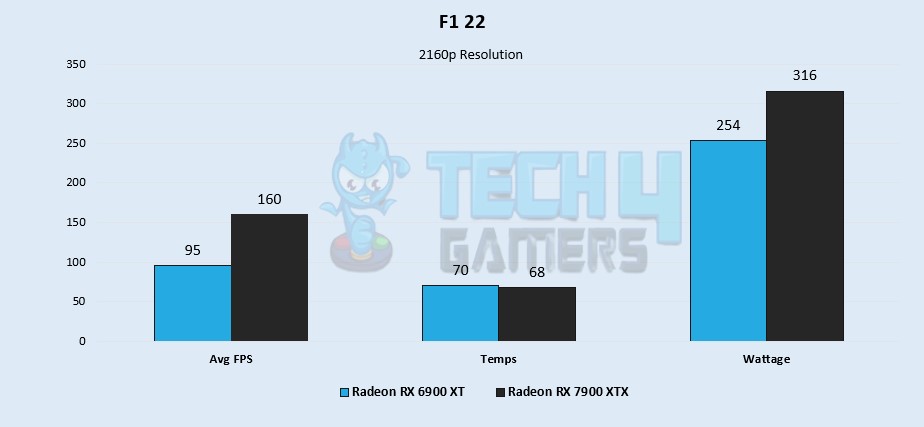
- No surprise in this test either, as I found the Radeon RX 6900 XT was confined to a 95 FPS average compared to an average of 160 FPS on the Radeon RX 7900 XTX.
- My extensive testing revealed that the Radeon RX 7900 XTX delivered a substantial performance boost of over 68%. This significant improvement in performance makes it a compelling choice for demanding gaming and creative tasks.
- In my testing, I found that the Radeon RX 7900 XTX consumes 316W, which is noticeably higher than the 254W power consumption of the Radeon RX 6900 XT.
- The temperature difference of 2°C is negligible during my test, but it is noticeable that the Radeon RX 7900 XTX is on the lower side.
Forza Horizon 5
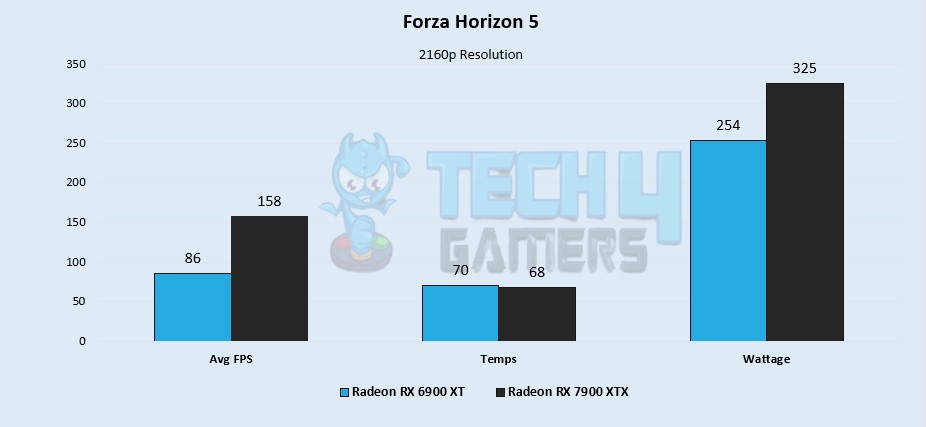
- While benchmarking the latest title from Forza, the Radeon RX 7900 XTX is passing this test with flying colors as I noticed it with an average of 158 FPS compared to only 86 FPS from Radeon RX 6900 XT.
- In terms of performance, I am getting 65% faster per-second frame generation from Radeon RX 7900 XTX than from Radeon RX 6900 XT.
- Radeon RX 6900 XT uses much less power by drawing only 254W from the motherboard than Radeon RX 7900 XTX, drawing 325W.
- During my testing, I observed that the Radeon RX 6900 XT runs just 2°C hotter than its rival, the Radeon RX 7900 XTX. These results are based on our hands-on experience and extensive assessments.
Similar Read: RTX 4070 Vs RX 7900 XTX
God Of War

- The performance difference is clear yet again in my test of God of War as the Radeon RX 7900 XTX delivers an average of 101 FPS, whereas the RX 6900 XT manages only 70 FPS.
- Every second, I was getting 31 extra frames on average from Radeon RX 7900 XTX compared to its competing GPU.
- Radeon RX 6900 XT uses 62W less power than its opponent by keeping its consumption at 264W.
- Radeon RX 7900 XTX is 4°C at 67°C compared to 71°C on Radeon RX 6900 XT.
Red Dead Redemption 2
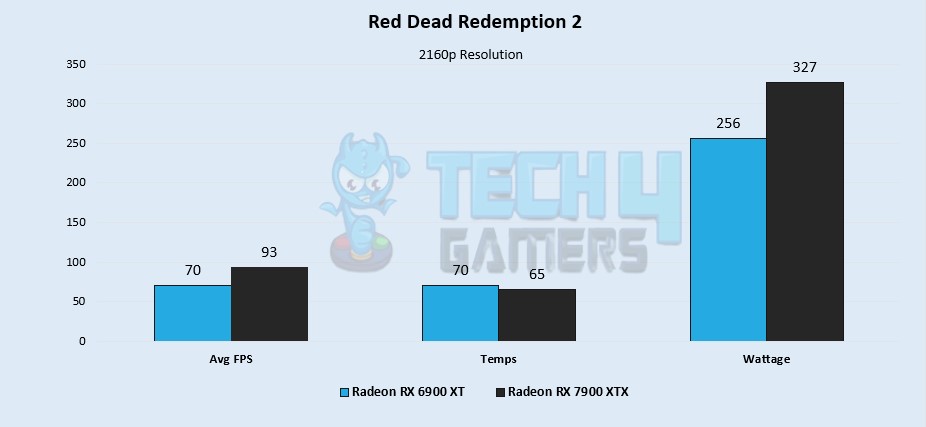
- I found both AMD graphics cards struggled with Red Dead Redemption 2, as none could deliver an average FPS of more than 100.
- With an average of 93 FPS, the Radeon RX 7900 XTX was 33% better in frame generation than the Radeon RX 6900 XT.
- It’s the same story in the TDP section as Radeon RX 6900 XT remains less power-hungry by consuming 256W compared to Radeon RX 7900 XTX’s 327W during my benchmark tests.
- The temperature is 5°C lower on the Radeon RX 7900 XTX, which is shocking after considering its power consumption compared to Radeon RX 6900 XT.
Another Read: RTX 4070 Ti Vs RX 7900 XTX
Spider-Man Remastered
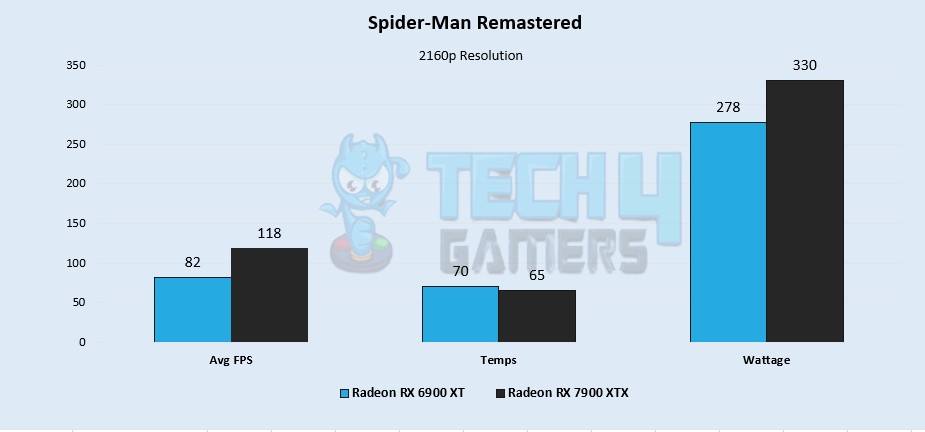
- Another huge performance gap became evident while I was playing Spiderman, as the Radeon RX 6900 XT was only able to deliver an average of 82 FPS.
- With an average of 118 FPS, the Radeon RX 7900 XTX was nearly 44% better in frame rate production than the Radeon RX 6900 XT.
- The power consumption difference has reduced in my benchmarks a little, but it’s still significant, with the Radeon RX 7900 XTX using 51W more than the Radeon RX 6900 XT.
- Yet again, the Radeon RX 7900 XTX surprised us by being at only 65°C despite using more power than the Radeon RX 6900 XT, which is at 70°C.
The Witcher 3
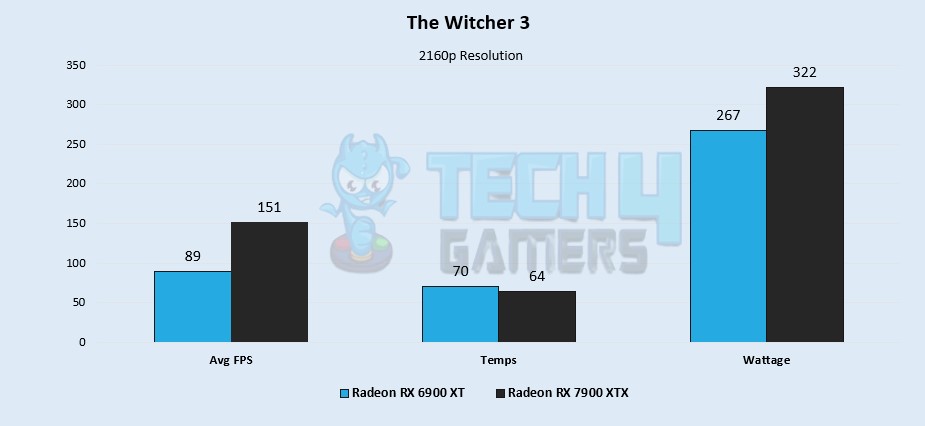
- The Radeon RX 7900 XTX was tremendously better during my testing of The Witcher 3 than the Radeon RX 6900 XT as it offered 151 FPS compared to only 89 FPS.
- I got 62 more frames every second from the Radeon RX 7900 XTX, which is 70% better FPS than the Radeon RX 6900 XT is giving us.
- Power consumption is high on Radeon RX 7900 XTX’s side at 322W compared to 267W on Radeon RX 6900 XT’s side.
- It’s a huge shock that despite using many more watts than Radeon RX 6900 XT, Radeon RX 7900 XTX is 6°C at only 64°C.
Read More: RX 7900 XTX Vs RX 7900 XT
Valorant
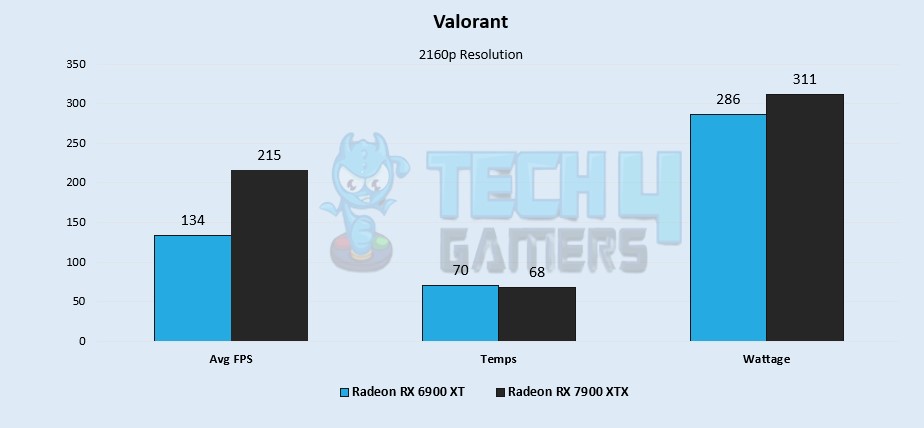
- The performance difference between the Radeon RX 7900 XTX and Radeon RX 6900 XT is day and night when I consider 215 FPS vs 134 FPS, respectively, during my Valorant Benchmarks.
- Radeon RX 7900 XTX was able to deliver a 60% faster frame generation rate than Radeon RX 6900 XT.
- Surprisingly, the power consumption difference, in this case, was very small, i.e. 26W, with Radeon RX 7900 XTX using 26W more.
- The trend continued in terms of temperature as the Radeon RX 7900 XTX was at 68°C compared to the Radeon RX 6900 XT being at 70°C.
Overall Gaming Performance
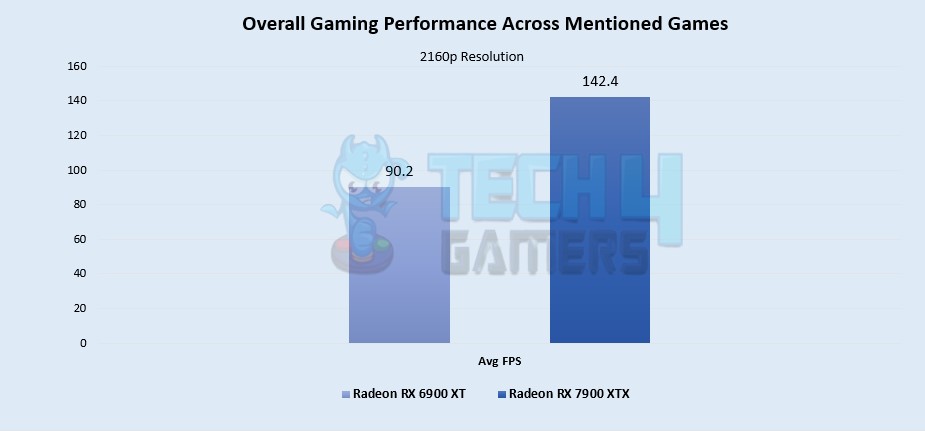
- In my 4K gaming benchmarks, the Radeon RX 7900 XTX stands out as the clear winner, offering consistently superior performance across all tested games.
- When considering the average FPS across all tested games, the Radeon RX 6900 XT achieved 90.2 FPS, whereas the Radeon RX 7900 XTX delivered an impressive average of 142.4 FPS, marking an overall performance improvement of approximately 44.8%.
Another Comparison: RX 7900 XTX Vs RTX 3080 Ti
Average Power Consumption
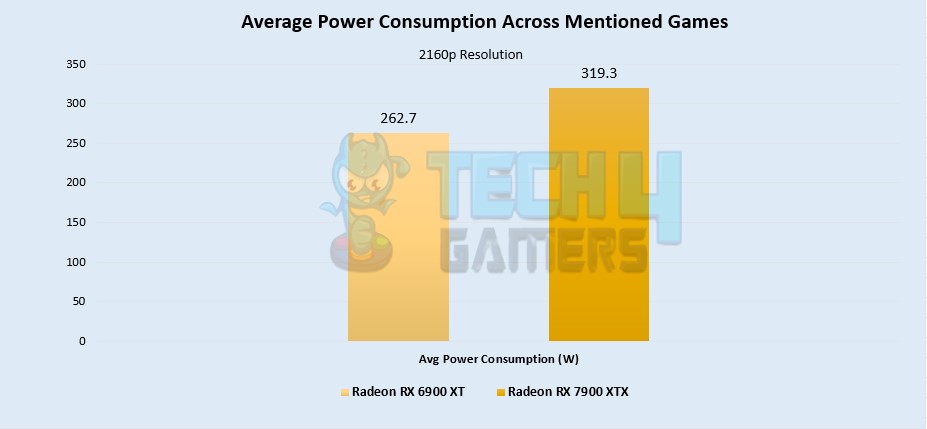
- When considering their average power consumption across various scenarios, I observed that the Radeon RX 6900 XT used 262.7W on average, in contrast to the Radeon RX 7900 XTX, which consumed an average of 319.3W.
- Consequently, based on these findings, I can assert that the Radeon RX 6900 XT proves to be more than 19.4% more power-efficient than the Radeon RX 7900 XTX.
Also Read: RTX 4090 Vs RX 6900 XT
Average Thermal Statistics
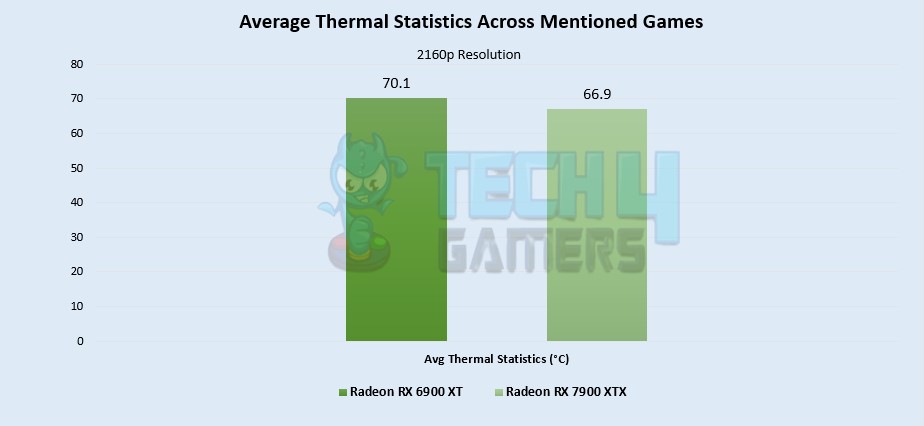
- The Radeon RX 7900 XTX maintained an average temperature of 66.9°C, while the Radeon RX 6900 XT recorded an average temperature of 70.1°C.
- Although the difference may seem small at just 4.6%, it underscores the impressive efficiency of AMD’s new GPUs.
Pricing And Availability
- As I was going through multiple platforms checking for availability, the RX 6900 XT is currently available at an approximate price of 800 USD on platforms like Newegg.
- In contrast, the RX 7900 XTX boasts an MSRP of 999 USD, resulting in a substantial price difference of 22.2%.
RX 6900 XT Vs RX 7900 XTX: Which One Would I Recommend?
- Based on my firsthand experience, I wholeheartedly recommend the Radeon RX 7900 XTX over the RX 6900 XT for its remarkable 44.8% improvement in average FPS across all tested games.
- In terms of power efficiency, my findings reveal that the Radeon RX 6900 XT surpasses the RX 7900 XTX by more than 19.4%, making it an eco-conscious choice for performance.
- Despite the seemingly minor 4.6% temperature difference, it showcases the impressive efficiency of AMD’s latest GPUs, adding to the appeal of the Radeon RX 7900 XTX.
Pros And Cons
| GPU | Pros | Cons |
| Radeon RX 7900 XTX |
|
|
| Radeon RX 6900 XT |
|
|
Thank you! Please share your positive feedback. 🔋
How could we improve this post? Please Help us. 😔
[Comparisons Expert]
Abdemanaf is a skilled creative writer who has been honing his craft since 2011. While initially working in different fields, he found a passion for technology and has been exploring the tech world since early 2015. Over the years, he has developed an in-depth knowledge of the latest tech trends and product offerings by various companies.
Abdemanaf’s writing reflects his analytical mindset and ability to think critically. He has a knack for breaking down complex technical information into easily digestible pieces, making his articles engaging and accessible to readers from all backgrounds. In February 2022, he joined Tech4Gamers as a blog and product comparison writer, where he has been able to hone his skills further.
As a writer, Abdemanaf is dedicated to staying up-to-date with the latest technological advancements and trends, enabling him to provide readers with the most relevant and accurate information. He is always eager to learn more and is constantly seeking new challenges to improve his skills.
Get In Touch: manaf@tech4gamers.com


 Threads
Threads![GTX 1660 Ti Vs RTX 3050 [We Tested Both]](https://tech4gamers.com/wp-content/uploads/2023/06/GPU-Comparison-Template-NEW-1-1-218x150.jpg)
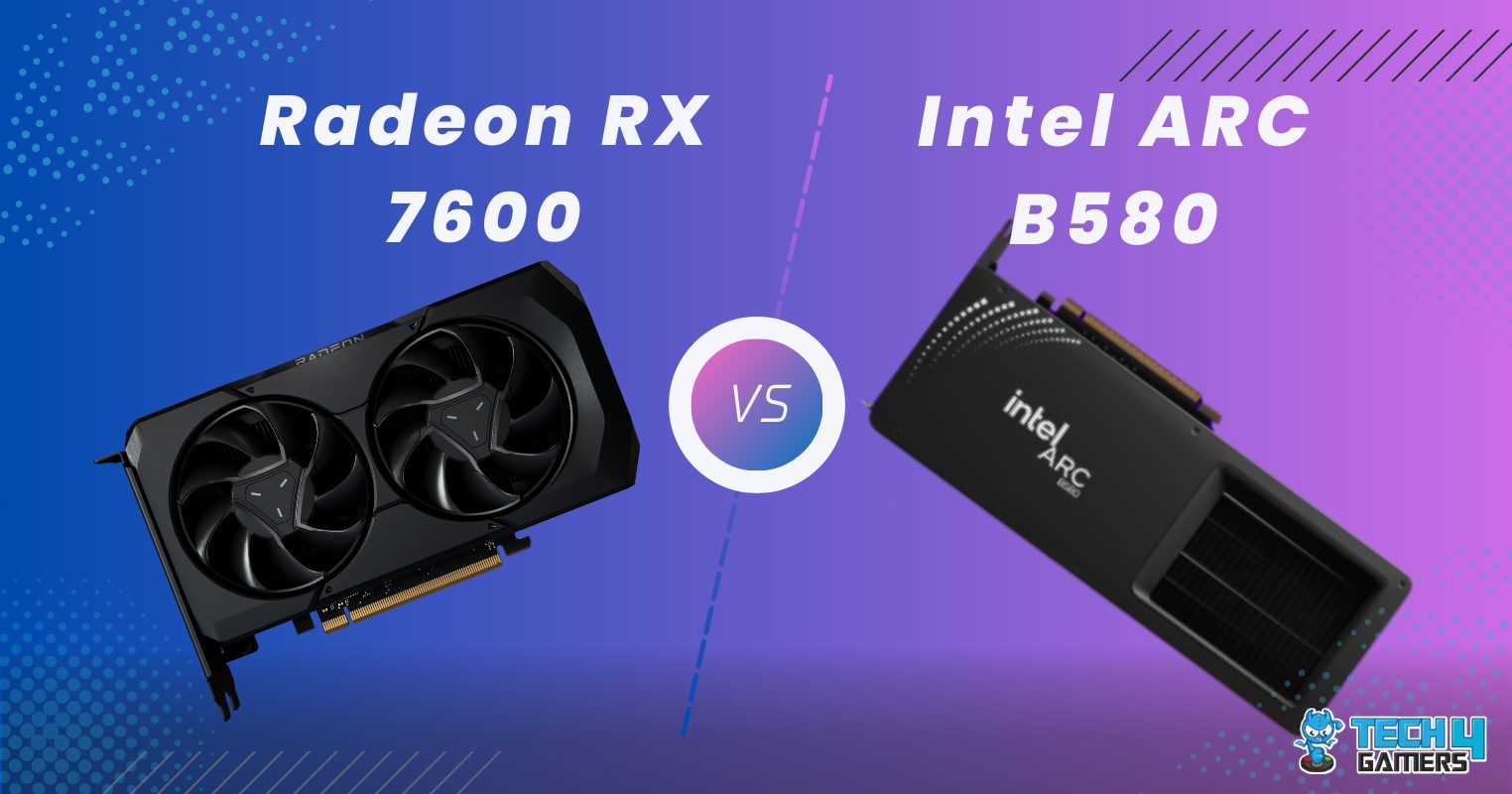
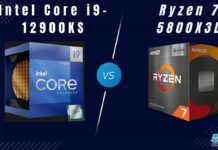
![RTX 4070 Vs RX 6900 XT [10 Games Tested] RTX 4070 Vs RX 6900XT](https://tech4gamers.com/wp-content/uploads/2023/05/RTX-4070-Vs-RX-6900XT-218x150.jpg)
